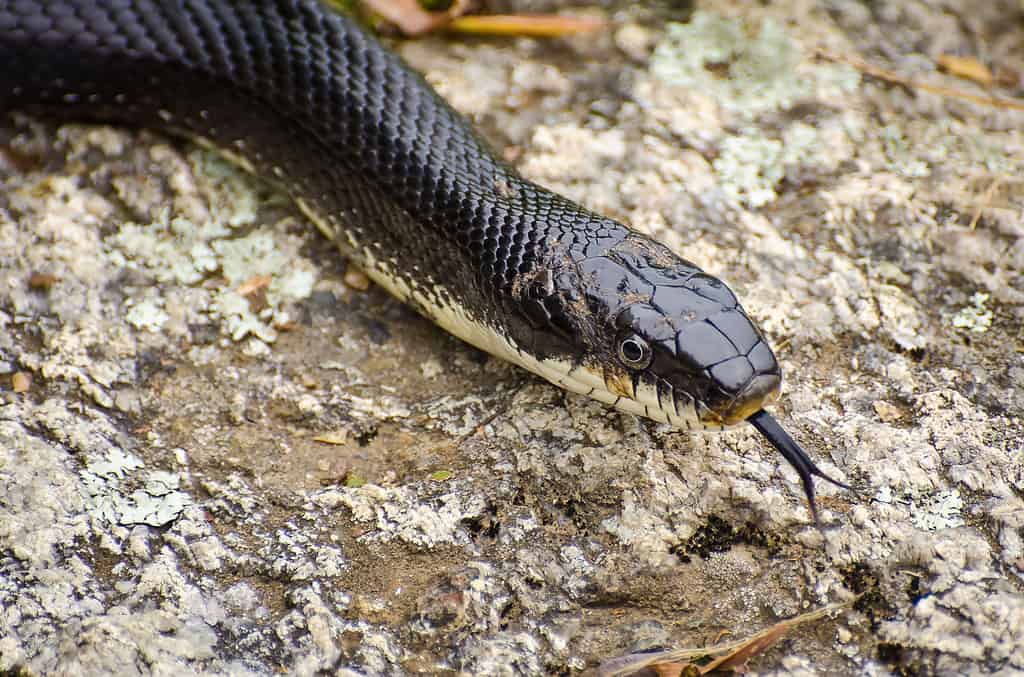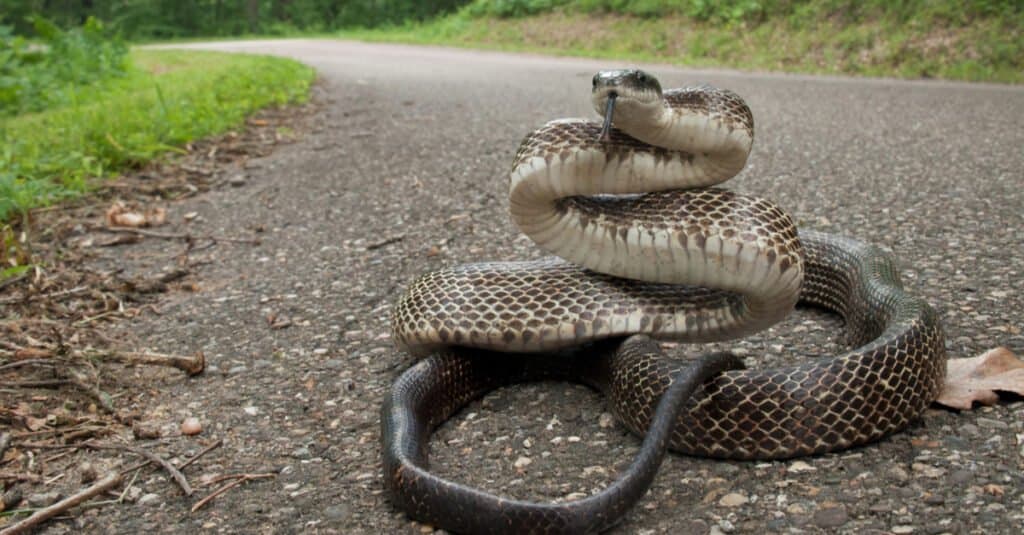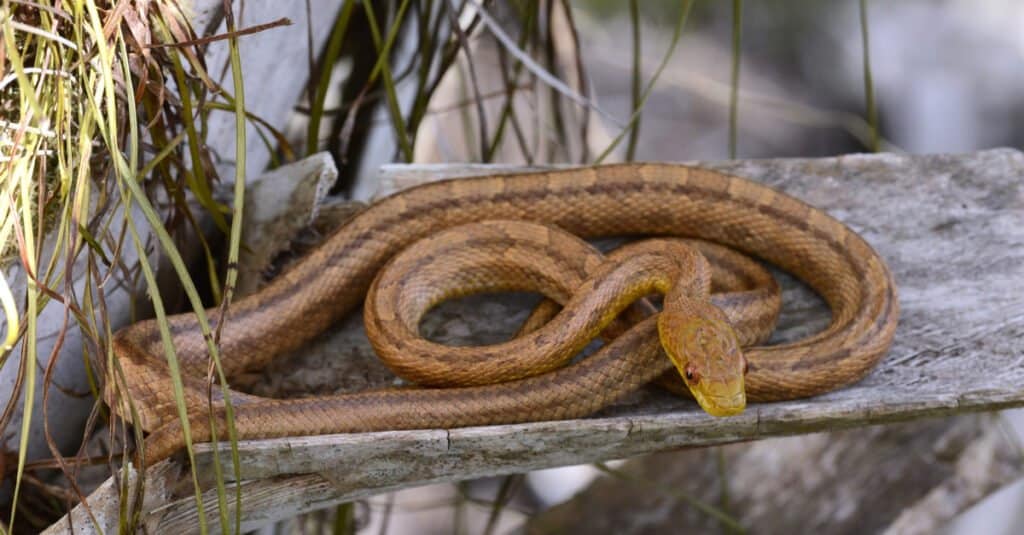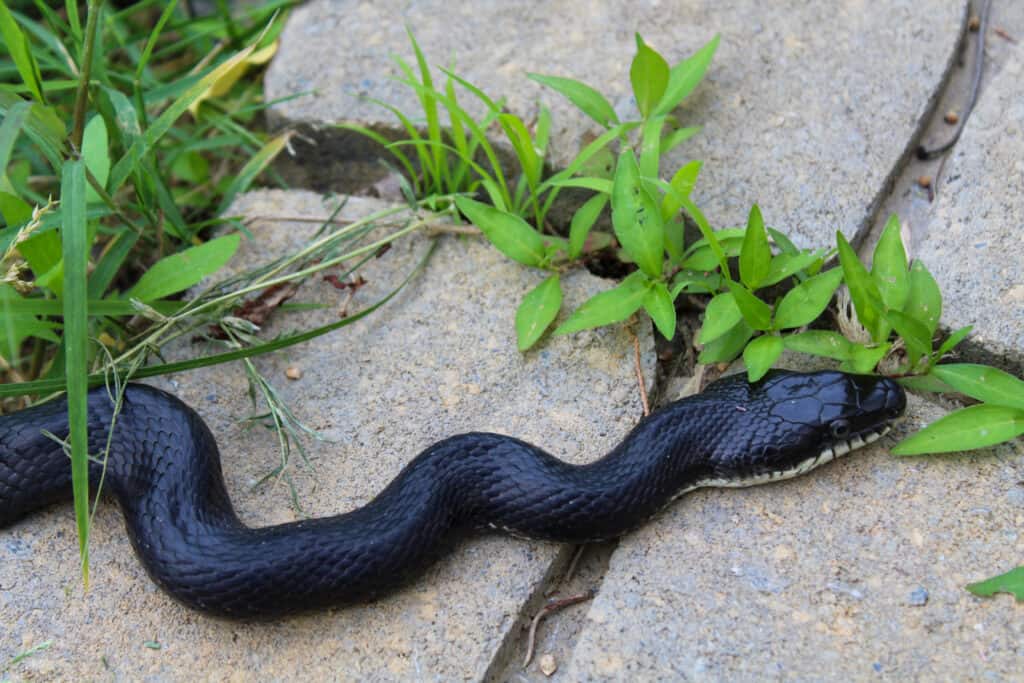While seeing a snake can give you the heebie-jeebies, it isn’t always a creature to fear. It’s generally a good idea to stay away from venomous snakes, but rat snakes are gentle giants. Rat snakes typically grow up to eight feet, depending on the species. They are neither poisonous nor dangerous, but they may bite as a last option if confronted or trapped.
Rat snakes are non-venomous constrictors, and because of their gentle nature and low maintenance requirements, they are ideal pet snakes for beginners. It’s also unlikely that these docile creatures will attack upon human contact, and they are beneficial to humans, especially farmers, in controlling rodent populations.
Do Rat Snakes Bite?

If provoked, rat snakes will bite in self-defense.
©iStock.com/RCKeller
Most common rat snakes can bite in self-defense, especially if provoked. Although the bite of a rat snake isn’t fatal, it can be rather painful. Bites from rat snakes are also full of bacteria that can infect you. Even though they do not contain venom, these snakes can grow quite large. They aren’t usually harmful to people, and we can approach them with caution. With the proper care and attention, they can be good companions.
Are Rat Snakes Dangerous to Humans?

Since black snakes only bite when provoked, they hardly pose a danger to humans.
©Mike Wilhelm/Shutterstock.com
The non-venomous status of rat snakes has long been a wonder, but new research has revealed that some Old World species contain a small amount of venom, though the amount is negligible relative to humans. Black snakes aren’t dangerous to people, so there is no reason to be afraid of them. They may bite, but only when provoked or cornered.
There are over 45 species of rat snake, but let’s take a closer look at the most common ones and see what the relationships between them and humans are like:
- Black Rat Snakes – Even though they are not naturally hostile, people are terrified of their size. They are often subject to unwarranted persecution simply because they are huge. The truth is that if you see one in the vicinity of a trash dump, abandoned building, or barn, leave it alone because black rat snakes help in lowering resident rodent populations.
- Gray Rat Snakes – These snakes can either flee for safety or remain immobile to evade detection if approached. When cornered, both juveniles and adults will take an S-shaped posture and strike at the assailant while rapidly vibrating the tip of their tail, resulting in a buzzing sound in the leaf litter. When held, however, these snakes usually calm down quickly. Despite this, these snakes aren’t aggressive, and biting is only a last resort in case of an attack.
- Yellow Rat Snakes – There have been reports that some old species can be potentially harmful due to the presence of minor levels of venom, but the truth is they aren’t dangerous at all. Newborns are more prone to biting as a self-defense than adult ones, though. Although captive rat snakes are more friendly than wild rat snakes, they still ward off humans the same way they do to other predators.
- Red Rat Snakes – Often mistaken as copperheads, red rat snakes are also called corn snakes because farmers used to keep corn in big containers, which attracted rats to eat it. The strategy then helps the corn snake feed on the rodents. They are excellent at evading danger and making fast escapes. Even if they aren’t deadly to people, we pose a threat by killing them unnecessarily, thinking they are poisonous copperheads.
- Texas Rat Snakes – These snakes can be defensive when it comes to people. Some may open their lips and try to bite when disturbed, but most prefer to flee and hide. They can mimic the considerably more dangerous rattlesnake by vibrating their tails in the hopes of fooling predators. If this mimicry fails, the rat snake can discourage predators by releasing a foul-smelling substance around it.
Are Rat Snakes Poisonous?

Rat snakes are not poisonous to humans as they kill by constriction.
©Patrick K. Campbell/Shutterstock.com
Although the words ”poisonous” and ”venomous” were once used almost interchangeably, they have different definitions. Poisonous refers to something that you either eat or otherwise touch that makes you sick. This includes things like poison ivy that gives you a nasty reaction. On the ther hand, venom must be injected into your body.
Most rat snakes are friendly, but some species will become more aggressive if cornered. The good thing is that these snakes are not poisonous to humans. Rat snakes kill their prey by constriction. Since humans are not part of their natural diet, there is no reason to fear getting attacked.
Rat snakes can release a foul-smelling musk instead of rearing up and fighting against a much larger predator. The taste of this musk is similar to that of poison, but it isn’t poisonous at all. If you are worried about having your pets bitten by snakes, dogs and snakes will usually avoid each other and rarely come into actual contact, hence a snake bite would be rare.
Are Rat Snakes Good to Have Around the House?

There are people who like having black rat snakes around because they keep the mice away.
©ButtermilkgirlVirginia/Shutterstock.com
The short answer here is yes! Certain species that pose no threat to humans sometimes feed on venomous snakes, thereby decreasing the likelihood of encountering a poisonous serpent. Which is a huge plus!
Some people welcome black rat snakes beneath their porches or in nearby trees as they help control rodent populations.
Further, black rat snakes are skilled climbers, often ascending trees and utilizing cavities or hollows once inhabited by other creatures, including birds or mammals.
This allows them to prey on pests keeping certain species of invading animals under control.
What Do Rat Snakes Eat?
Rat snakes include rodents, frogs, lizards, birds, eggs, voles, mice, and chipmunks in their primary diet. They are constrictors, so they squeeze their prey to death before swallowing it whole. However, there are a few typical misunderstandings regarding how this works. One is that their prey’s bones are crushed or broken by constriction.
Another possibility is that they suffocate the victim by squeezing the prey’s lungs so hard that it cannot breathe. The pressure, it turns out, harms the circulatory system. Ischemia prevents blood from reaching the brain, and the prey dies in a matter of seconds.
Rat snakes are known to continue hunting after they have killed their victims. They do this because other animals are less likely to detect them if covered with their prey’s scent. Because they also tend to consume chicken eggs, some rat snake species are called chicken snakes.
How to Avoid Rat Snake Bites
Most snake bites occur between April and October. Avoiding areas where snakes may live is a great way to avoid snake bites. Tall grass or vegetation, rocky terrain, fallen logs, cliffs, swamps, marshes, and deep holes in the earth are all examples of these types of environments.
Even if you think a snake is dead, never touch it. Some recently killed snakes may remain dangerous long after they are dead. In conclusion, avoid disturbing or threatening snakes, especially in the wild.
The photo featured at the top of this post is © Patrick K. Campbell/Shutterstock.com
Discover the "Monster" Snake 5X Bigger than an Anaconda
Every day A-Z Animals sends out some of the most incredible facts in the world from our free newsletter. Want to discover the 10 most beautiful snakes in the world, a "snake island" where you're never more than 3 feet from danger, or a "monster" snake 5X larger than an anaconda? Then sign up right now and you'll start receiving our daily newsletter absolutely free.
Thank you for reading! Have some feedback for us? Contact the AZ Animals editorial team.






